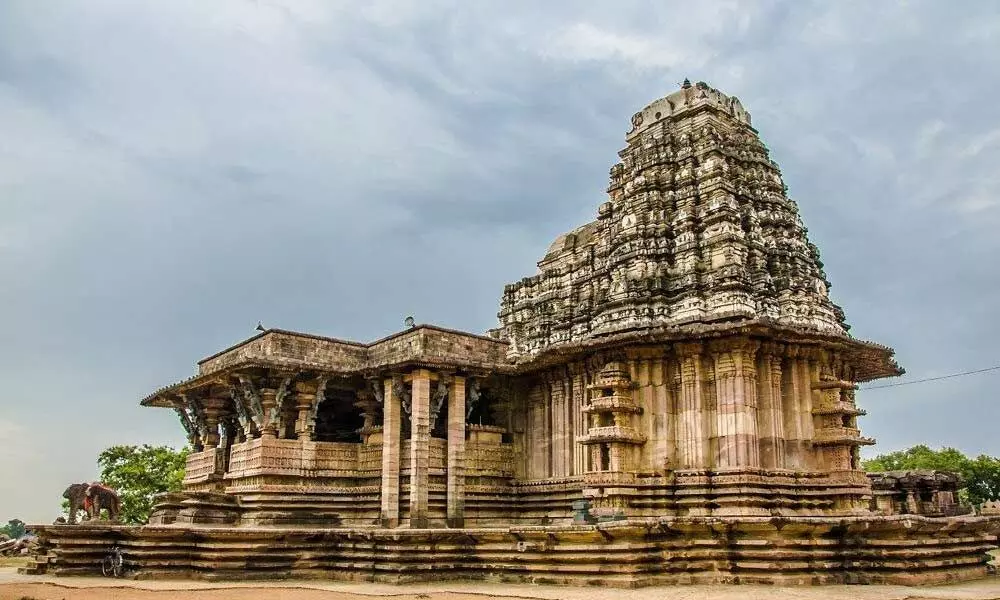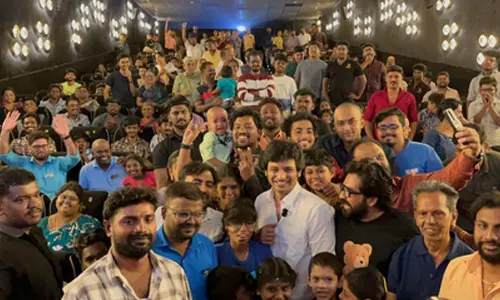Ramappa Temple: A masterpiece of Kakatiya architecture

Ramappa Temple
This 13th century temple, perhaps the only temple to be named after its architect Ramappais said to be built for 40 years in the interest of RecharlaRudra, general of the then Kakatiyan ruler Ganapati Deva
The sandbox technology, floating bricks used in the construction of pyramidal vimana (horizontal stepped tower) bagged theUNESCO heritage site status to Ramappa temple, making it the 39th such a site in the country, and the first in both the Telugu states.
It's no wonder to say that Ramappa temple stands exemplary for Kakatiyan architecture but what is striking, is its engineering marvel thathas bagged it the most prestigious UNESCO world heritage site tag recently at the 44th UNESCO session of World Heritage Committee held in China.This 13th century temple, perhaps the only temple to be named after its architect Ramappais said to be built for 40 years in the interest of RecharlaRudra,general of the then Kakatiyan ruler, Ganapati Deva. Earlier, a miniature of a similar temple was built in the temple premises and the original temple was constructed seeing this miniature temple (which is seen even today).
Ramappa temple also known as Kakatiya Rudreshwara temple stands on a 6-feet raised star-shaped platform using sandbox technology which involves filling the pit -dug up for laying foundation with a mixture of sandlime, jaggery (for binding) andkarakkaya (a black myrobalan fruit) that can absorb the waves of an earthquake. Notably, the temple'svimana is constructed with light-weight porous bricks so as not to burden the temple roof structures. These bricks are also stand as proof for experimentation of those times and are made of clay mixed with acacia wood, chaff, myrobalan and ushira, also known as vattiverlu, making the brick very light, and enabling it to float on water and this feature quite impressed the UNESCO committee.
This east-facing temple has three entrances and the presiding deity is Lord Ramalingeshwara Swami. It is mainly built of rare red sandstone while the pillars and sculptures are carved out of black basalt, granite and dolerite. The beauty of the temple lies in the minute details showcasing the culture and customs of Kakatiyas.
The three entrances are flanked by two pairs of bracketfigures of dancing girls each, totalling to twelve and there are also Yali brackets that spring from outer pillars of the temple and stand as if they are supporting the roof structures. These voluptuous dancing figures usually referred to as mandanikas are carved and polished to perfection. Their body postures, facial expressions, embroidered costumes and intricate jewellery are exquisitely carved and have unique characteristics.One of them is seen wearing high heels, other is seen with long finger nailswhich are considered as modern-day fashion. A bracket figure showing a monkey pulling the garment of a feminine, and the other depicting the sight of a man trying to remove throne from the feet of other mandakini, a women drummer, and nagini (snake woman)are some of the spectacular artworks here.
There is a chain of 526 elephants' and other flower motifs on the temple walls showing devoteesthe direction of circumambulation which is an integral part of Hindu temple practice. Wrestling postures, dance postures, Hindu gods and goddesses, Jaina figures are also carved on the temple. One can also find Eygptian and Persian figures which reminds us of the prevailing international trade of that time.
Once you enter the temple, you are welcomed by grandeur of massive pillars still retaining their black polished lustre even after 800 years.Every inch of the temple exhibits the sculptural excellence in the form of carved rishis, freezed elephants, freezed lions, Narasimha, Ganesha, flower motifs and so on. The inside pillars and spacingof outer walls are so arranged that the Shiva Linga in sanctum sanctorum is always illuminated by the light reflected from the pillars of the temple. These decorated pillars divide the ceiling into compartments,which are again carved with numerous stories from Hindu mythologies likeBhagvatha, Shiva purana, Ramayana etc. The intricate holes in the sculptures that couldallow only a straw of grass, 3D figures showing seven persons using only 12legs, bamboo tree carving which makes rhythmic sounds when touched, are other highlights. A beautifully adorned Nandi is seen in alter position facing the Lord in a separate mandap outside the temple.
Many dance postures of JayapaSenani'sNrithyaRatnavali appear on the temple walls. Perini Shiva Tandavaram, Telangana's State dance form is revived through the sculptures near the santumsanctoram of this temple by Dr Nataraja Ramakrishna.The temple premises, also has a mandapa erected for an inscription issued by RecharlaRudrain 1213AD which gives historical credence.Also, there are two more small shrines, namely Kameshwara and Kateshwara temples inside the temple premises.
Thus we can say that this temple stands as museum of Kakatiyan artforms. Floating bricks used in temple vimana, sandbox technology, richly decorated beams, sculptures carved out of granite and dolerite pillars depicting various stories from mythologies, regional dance and other art forms exemplifying Kakatiya culture made it to attain universal value of World heritage site to Ramappa temple.
Marcopolo, a Venetian merchant and traveller, hailed this temple as a brighter star in the galaxy of temples of medieval era.
Due to sandbox technology employed, the temple survived amassive earthquake in seventeenth century only damaging the temple floor. Many small structures and outer boundary are in ruins.It stands intact even after repeated wars, plunder and natural disasters.
Though located at a remote village named Palampeta in Venkatapurmandal of Mulugu district of Telangana, it can be easily reachable by road transport. The UNESECO heritage tag will definitely revive the temple's glory galvanizing domestic and international tourism not only to this temple but also to the other nearby tourist places like Khila Warangal, 1000-pillared temple, Kota Gullu, LaknavaramLake, Ramappa lake etc.














